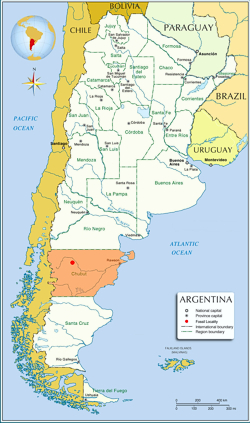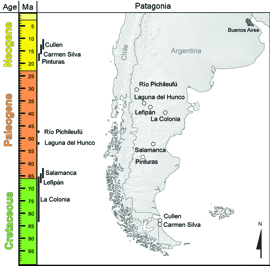
The Lefipán paleoflora is a diverse fossil assemblage including pollen and megafossils (e.g., leaves, branches, etc.). This flora is thought to be latest Cretaceous (Maastrichtian) in age, about 65.5-66 million years old, based on the types of marine invertebrates found in the Lefipán Formation (the geologic unit bearing the flora). The paleoflora has two distinct parts. The lower part bears conifers and flowering plants, including the plant Nelumbo; Nelumbo is commonly known as the lotus and is also found in the La Colonia paleoflora. The upper part contains ferns, conifers, and flowering plants. The species diversity of this flora is not yet described in the scientific literature. Understanding the diversity of this paleoflora will be an important part of understanding how the ancient Patagonian flora was affected by the end-Cretaceous mass extinction, which occurred about 65.5 million years ago and was the extinction event during which the dinosaurs died out.
The Lefipán formation comprises a rich fossil flora dominated by angiosperms and gymnosperms and ferns as secondary components. In particular, understanding the flora of Lefipán is critical as the formation was deposited at the end of the Cretaceous (Maastrichtian) and the beginning of the Paleocene (Danian), crossing the K/Pg boundary. Angiosperms are represented by more than 90 morphotypes. Among the gymnosperms, podocarp and araucarian remains are the best represented.
Gandolfo Lab Research
Study of the flora of the Lefipán is a collaborative effort between researchers at several institutions, including the Gandolfo lab at Cornell University (Ithaca, New York) and the Museo Paleontológico Egidio Feruglio (Trelew, Chubut Province, Argentina). The primary goal of this project is to document the diversity of the flora.
Lab Work
Much of the detailed work involved in describing and understanding species of fossil plants takes place in the lab. We employ many traditional methods of paleobotanical study, such as making observations, describing fossil species, and comparing fossil species to living plants, in order to understand the plants that we find in the field. In addition, we use modern analytical techniques to attempt to gain a more precise understanding of the evolutionary relationships of fossil and living plants.
Other Paleofloras
(Youngest-Oldest)
- Cenozoic Paleofloras
- Cullen (middle Miocene)
- Carmen Silva (Miocene)
- Pinturas (late-early Miocene)
- Río Pichileufú (early-middle Eocene)
- Laguna del Hunco (Early Eocene)
- Salamanca (early Paleocene)
- Cretaceous Paleofloras
- Lefipán (Maastrichtian- 65.5-66 myo)
- La Colonia (Campanian to Maastrichtian)
